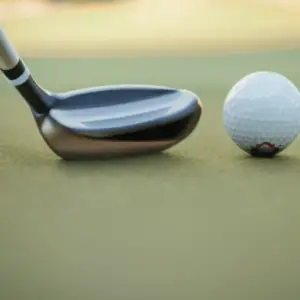Last Updated on June 5, 2023
Golfers everywhere know the feeling of frustration when they spot a scratch on their favourite golf club. But don’t despair – it’s possible to remove scratches from your clubs and restore them back to looking like new. With some patience, you can easily fix those unsightly marks without having to buy an entirely new set of clubs. In this blog post, we’ll explore how to remove scratches from golf clubs and give your beloved sticks that perfect shine once again. So grab a few tools and get ready for a little DIY action – let’s get started.
Table of Contents:
- Assessing the Damage
- Preparing for Repair
- Sanding Away Scratches
- Polishing Out Deeper Scratches
- Finishing Touches
- FAQs in Relation to How to Remove Scratches From Golf Clubs
- Conclusion
Assessing the Damage
When examining the harm done to golf clubs, multiple factors must be considered. Firstly, how deep is the scratch? If it’s just a superficial one that only affects the surface of your club, then chances are it can be easily repaired with some sanding and polishing. However, if the scratch has penetrated deeper than this, then more drastic measures may be needed in order to restore its original condition.
Next to mull over is the material of your club – whether it be steel or graphite. Different materials require different methods for repair; steel clubs will usually respond better to buffing and polishing, while graphite shafts often require more delicate treatment, such as filling or patching up any holes left by scratches.

Finally, look at where on the club head or shaft itself does the scratch appear? Is it near any important components like grooves or ridges, which could affect performance if not repaired correctly? If so, then extra care must be taken when attempting repairs, as these areas can easily become damaged further if handled incorrectly.
It’s always best practice when assessing damage on golf clubs – whether minor scuffs or major gouges – to assess each individual case carefully before taking action and make sure all necessary steps are taken in order to avoid causing further harm during repair work. With patience and attention to detail, even seemingly severe scratches can be fixed without compromising quality, so don’t let a little bit of wear-and-tear put you off playing your favourite game.
Analyzing the harm is a significant measure in deciding how to best fix a golf club. With that knowledge, it’s time to move on to preparing for repair.
Preparing for Repair
When it comes to preparing for repair, there are a few materials and tools that you’ll need to have on hand. Whether you’re looking to remove light scratches or deep sky marks from your golf clubs, the process is fairly straightforward.
For light scratches and small scuff marks, all you need is a clean cloth and some metal polish. Start by wiping down the entire club head with the cloth in order to remove any dirt or debris that may be present. Then apply some metal polish onto the area where the scratch is located and gently rub until it disappears. If necessary, use a soft cloth after applying metal polish in order to buff out any remaining residue. This same method can also be used for removing deeper scratches as well as sky marks from modern golf drivers and irons.
Finally, finish up by applying automotive paint (if necessary), followed by an even coat of metal polish across the entire surface in order to prevent further rusting and give them back their original shine.
Preparing for repair involves gathering the necessary materials and making sure that the club is clean. Sanding away scratches requires a delicate touch, so it’s important to take your time when sanding down the affected area.
Sanding Away Scratches
Sanding away scratches is a process that requires patience and attention to detail. Choosing the correct grain of sandpaper is critical, as it will decide how much effort is necessary. For most minor surface scratches, an 80-grit paper should do the trick. When it comes to sanding golf clubs, you want to use circular motions for the best results. Begin with light pressure and gradually build up to the desired level of smoothness, focusing on small sections at once in circular motions.
It’s also important not to go overboard when sanding down your clubs; too much can actually cause more damage than good. The key here is balance: make sure that you don’t apply too much or too little pressure while sanding away any imperfections on your club face or shafts. If done correctly, this step should take no longer than 10 minutes per club head or shaft section being worked on – anything longer could mean that you are going against the grain of the metal which would result in further damage if continued over time.
Finally, remember that practice makes perfect when it comes to restoring golf clubs back to pristine condition. Taking extra care now will save you time later, and make sure that you do not go overboard when sanding down your clubs; too much can actually cause more damage than good. Balance is key here: apply the right amount of pressure while sanding away any imperfections on your club face or shafts for best results.
Sanding may be a good option for minor scrapes on golf clubs, but to tackle deeper scratches, it’s best to use polishing. Next, we’ll look at how you can polish out those more stubborn marks with ease.
Polishing Out Deeper Scratches
Polishing out deeper scratches from golf clubs can be a daunting task, but with the right tools and technique, it’s an achievable goal. The key is to use the proper supplies and take your time.

First off, you need to assess the damage. Look closely at where the scratch is located on the club and how deep it goes into the metal or graphite shaft. Once you’ve inspected the scratch without a magnifying glass, use a flashlight to get an even clearer view of what needs attention. Once you have determined that there are no chips or cracks in either material – which would require professional repair – then you can move on to preparing for repair.
You will need several items: fine-grit sandpaper (400 grit), medium-grit sandpaper (600 grit), steel wool pads (000 grade) and a polishing compound made specifically for golf clubs (or brasso). You may also want some gloves if you plan on doing any hand sanding, as well as safety glasses in case of flying debris when using power tools such as an electric drill with attachments like buffing wheels or wire brushes.
Now that everything is ready, start by lightly sanding away any surface scratches with 400 grit paper before moving up to 600 grit paper for deeper scratches until they appear smooth upon inspection under magnification or a strong light source. Be sure not to press too hard when sanding so as not to create more damage than necessary; slow strokes work best here.
Finally, finish up by applying a wax coating afterwards so that a new layer of protection against future wear and tear can be applied, thus maintaining the freshness and vibrancy associated with pristine condition golf clubs.
Polishing deep gouges can be a challenging endeavour, yet with the correct apparatus and strategies, and it is conceivable to bring your golf clubs back to their unique state. Moving on from here, we will look at some finishing touches that you can do in order to ensure that your golf club looks as good as new.
Finishing Touches
Finally, apply a thin layer of wax polish over your entire club head for added protection against future wear and tear. This will help keep its original glossy look for longer periods of time as well as protect it from moisture damage when playing in wet conditions outside. Use circular motions when applying this final coat of wax so that it evenly coats every surface area without leaving any streaks behind.
FAQs in Relation to How to Remove Scratches From Golf Clubs
How do you remove scratches from golf clubs?
Scratches on golf clubs can be removed with a variety of techniques. The most common method is to use an abrasive cloth or pad and gently buff out the scratches in a circular motion, using light pressure. For deeper scratches, metal polish tailored for golf clubs can be employed; yet, it should only be used if the scratch isn’t too profound as it could harm the club’s finish. Finally, some professionals suggest using toothpaste and a soft cloth for deeper scratches that won’t come out with other methods. Whatever technique you choose, always remember to clean off any residue after polishing before playing again.
How do you fix a scuff on the top of a golf club?
Start with a warm, soapy wash to clean the scuffed area of the golf club, then dry it off. Use fine-grit sandpaper to lightly buff out any remaining marks or discolouration. Then apply an even coat of polish to restore shine and protect from future damage. Finally, use a soft cloth to buff away excess polish for an even finish that looks as good as new.
Can you use magic eraser on golf clubs?
No, you should not use a magic eraser on golf clubs. Magic erasers are abrasive and can damage the finish of your club, as well as potentially cause rusting or corrosion. Additionally, using a magic eraser could leave behind residue that may be difficult to remove without further damaging the surface of your club. It is best to clean golf clubs with gentle cleaning solutions specifically designed for metal surfaces such as those used in golf equipment maintenance kits.
Do scratches on golf clubs matter?
Scratches on golf clubs do matter, as they can affect the performance of a club. Scratches and dings can cause an uneven contact between the ball and the face of the club, which will result in inconsistent shots. The deeper scratches may also reduce the overall durability of a club due to weakened materials at that point. Hence, it is essential for golfers to frequently assess their clubs for any signs of deterioration or damage so they can perform with certainty knowing their tools are in proper condition and performing optimally.
Conclusion
The key is to take your time when assessing the damage, preparing for repair, sanding away any surface level scratches and polishing out deeper ones. With patience and some elbow grease, you’ll have your club looking as good as new in no time.


